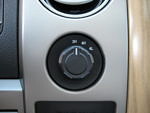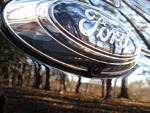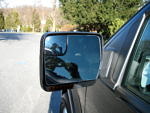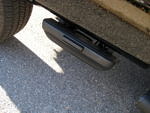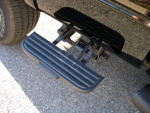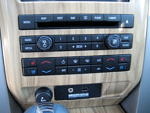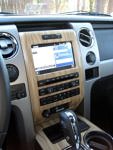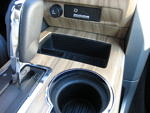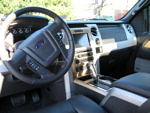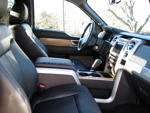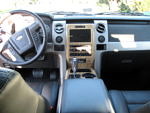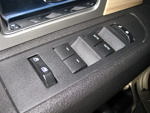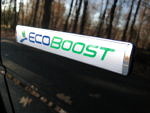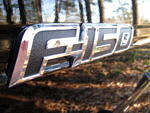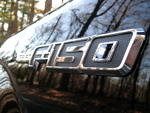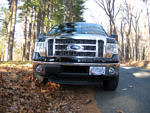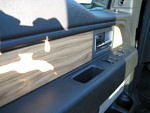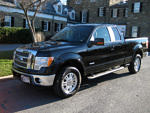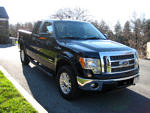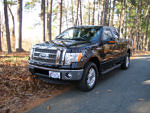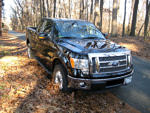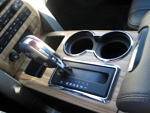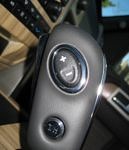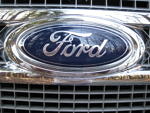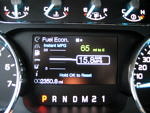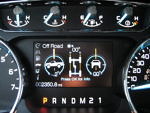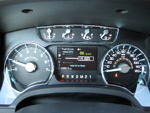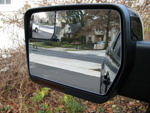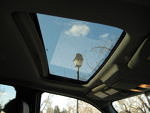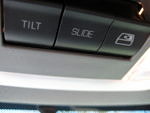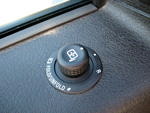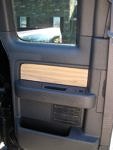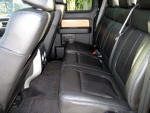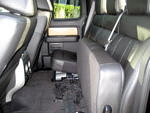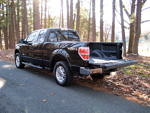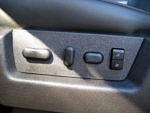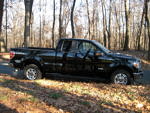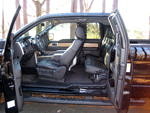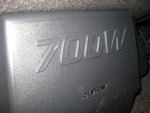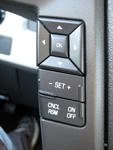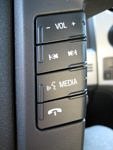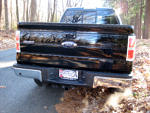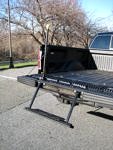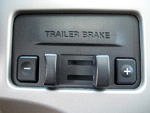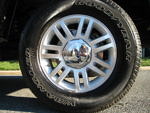 Two years ago, when I was starting up Road Reality, I reviewed a 2010 Ford F-150. It was a Lariat model with then-optional 5.4-liter V8. In that review, I said I was impressed. Since I was in the market for a full-size pickup truck and with a complete overhaul of the F-150’s engine options, a test drive of the new truck was in order. I also reviewed the 2011 GMC Sierra and test drove a 2011 RAM 1500, so the inevitable comparisons began in earnest – which you’ll find in an upcoming article. It may be a spoiler, but I brought the Ford F-150 home for good, trading in my 2010 Nissan Maxima. Continue reading for a full-on review of Ford’s latest F-150.
Two years ago, when I was starting up Road Reality, I reviewed a 2010 Ford F-150. It was a Lariat model with then-optional 5.4-liter V8. In that review, I said I was impressed. Since I was in the market for a full-size pickup truck and with a complete overhaul of the F-150’s engine options, a test drive of the new truck was in order. I also reviewed the 2011 GMC Sierra and test drove a 2011 RAM 1500, so the inevitable comparisons began in earnest – which you’ll find in an upcoming article. It may be a spoiler, but I brought the Ford F-150 home for good, trading in my 2010 Nissan Maxima. Continue reading for a full-on review of Ford’s latest F-150.
While the body has stayed the same since the last review truck, meaning it’s still handsome, the drive train has gotten a huge upgrade, and this truck has a few more options on it. For a refresher on last year’s truck, see my previous review.
 Outside, the sheetmetal work is handsome, definitely muscular, and slightly Tonka-truckish. While certain angles may make the F-150 appear small, it only appears so. With a wheelbase of 145″ when equipped with the extended cab (SuperCab) and 6.5′ bed, its overall length is 19.25′ feet long – more than twice the length of a Smart ForTwo. The F-150 is 97″ wide, just an inch and a half shy of the length of the Smart ForTwo.
Outside, the sheetmetal work is handsome, definitely muscular, and slightly Tonka-truckish. While certain angles may make the F-150 appear small, it only appears so. With a wheelbase of 145″ when equipped with the extended cab (SuperCab) and 6.5′ bed, its overall length is 19.25′ feet long – more than twice the length of a Smart ForTwo. The F-150 is 97″ wide, just an inch and a half shy of the length of the Smart ForTwo.
 Inside, the cabin is well-appointed, with a feature-rich steering wheel, the optional navigation system, SYNC, and for long-haul comfort, optional 10-way adjustable bucket leather seats featuring both heating and cooling. The amount and design of controls at hand are well thought out, although temperature knobs for the dual-zone automatic climate control would be nice. Furthermore, while there are a lot of plastic surfaces, they’re all nicely-grained. A bit of debate over the 2010 F-150 Lariat surrounds the color of the plastic wood trim, which went from dark in the old truck to lighter in the new one. At first, I thought it was a bit garish, but after spending some time behind the wheel, the light trim breaks up an otherwise dark feel. The front arm rests and other often-touched areas have been thankfully covered in soft-touch rubberized plastics, while the hard-plastic window sill isn’t at all uncomfortable to rest your arm on, if the weather permits rolling down the windows.
Inside, the cabin is well-appointed, with a feature-rich steering wheel, the optional navigation system, SYNC, and for long-haul comfort, optional 10-way adjustable bucket leather seats featuring both heating and cooling. The amount and design of controls at hand are well thought out, although temperature knobs for the dual-zone automatic climate control would be nice. Furthermore, while there are a lot of plastic surfaces, they’re all nicely-grained. A bit of debate over the 2010 F-150 Lariat surrounds the color of the plastic wood trim, which went from dark in the old truck to lighter in the new one. At first, I thought it was a bit garish, but after spending some time behind the wheel, the light trim breaks up an otherwise dark feel. The front arm rests and other often-touched areas have been thankfully covered in soft-touch rubberized plastics, while the hard-plastic window sill isn’t at all uncomfortable to rest your arm on, if the weather permits rolling down the windows.
 One area in particular that has seen a great improvement over the 2010 model is the instrument cluster. Whereas the previous model reminded you that you were driving a truck with chunky gauges, the 2011 model has blue-lit gauges with chrome bezels. They wouldn’t be out of place in a luxury sedan, and really add a touch of class to a truck with an MSRP of over $45,000. Ford has added its 4.2″ LCD to the instrument cluster of the 2011 F-150. While the standard trip odometers and instantaneous fuel economy displays are present, the F-150 also includes a “Truck Apps” display, which shows yaw, pitch, steering angle and 4×4 status. That, combined with the updated gauge cluster, present a higher-tech, more classy look.
One area in particular that has seen a great improvement over the 2010 model is the instrument cluster. Whereas the previous model reminded you that you were driving a truck with chunky gauges, the 2011 model has blue-lit gauges with chrome bezels. They wouldn’t be out of place in a luxury sedan, and really add a touch of class to a truck with an MSRP of over $45,000. Ford has added its 4.2″ LCD to the instrument cluster of the 2011 F-150. While the standard trip odometers and instantaneous fuel economy displays are present, the F-150 also includes a “Truck Apps” display, which shows yaw, pitch, steering angle and 4×4 status. That, combined with the updated gauge cluster, present a higher-tech, more classy look.
For 2011, Ford has done to the F-150 what it did to the Mustang: completely revamped the engine options. While the Mustang received new V6 and V8 engines, so has the F-150. The four new engines include a 3.7-liter V6, 5.0-liter V8, EcoBoost 3.5-liter V6, and a 6.2-liter V8. For the Lariat trim level, which I was in the market for, the 5.0-liter V8 is the base, with the EcoBoost being a $750 option. Having experienced both engines in the F-150, I preferred the EcoBoost for its greater capability and superior fuel economy. Ford’s torture test (and the results of that test) on a random EcoBoost also convinced me it had the chops to go the distance. Check out the torture test’s web site for yourself – there’s some fun videos there.
For those of you new to EcoBoost, it’s Ford-speak for twin-turbocharged and direct-injected engines, which it expects to be at least optional on 80-90% of its offerings in a few years. It gives the power of a V8, with better fuel economy. In four-wheel drive F-150s, the EPA rates the 5.0-liter V8 at 14/19 city/highway, while the EcoBoost V6 achieves 15/21 city/highway, a boon if you spend a significant amount of time on the highway.
 All the information on the EcoBoost means nothing without actually experiencing it from behind the wheel. The EcoBoost-equipped F-150 has prodigious amounts of power and torque for any situation you may encounter, whether it’s an uphill freeway on ramp or passing a slower-moving vehicle. Passengers have remarked to me that, “a truck just shouldn’t be this fast.” Since the EcoBoost engine in the review vehicle wasn’t fully broken in yet, there was a small amount of turbo lag, where the turbochargers took a second or so to spool up before really adding power to the V6. On a normal drive, you won’t ever notice the lag. It’s not until you really mash the gas pedal that it shows up. On the flip side, when cruising along at highway speeds, or even when coasting, the on-board computer will display a 22 to 24 MPG average, simply astounding for such a large vehicle with its boxy front end. When the road gets curvy, you’ll want to be traveling at reasonable speeds, since the top-heavy F-150 isn’t going to carve corners like a low-slung sports car. That being said, the truck’s handling is predictable, letting you know what’s going on at each corner. Should you find yourself going into a corner too fast, the brakes are more than capable of slowing the truck down without any commotion – commendable for a front-heavy rear wheel drive vehicle. Having actually had to panic stop in a corner, I can attest to the effectiveness of the brakes. They won’t stop the F-150 like the brakes on a sports sedan, but they definitely aren’t a “push and pray” setup either.
All the information on the EcoBoost means nothing without actually experiencing it from behind the wheel. The EcoBoost-equipped F-150 has prodigious amounts of power and torque for any situation you may encounter, whether it’s an uphill freeway on ramp or passing a slower-moving vehicle. Passengers have remarked to me that, “a truck just shouldn’t be this fast.” Since the EcoBoost engine in the review vehicle wasn’t fully broken in yet, there was a small amount of turbo lag, where the turbochargers took a second or so to spool up before really adding power to the V6. On a normal drive, you won’t ever notice the lag. It’s not until you really mash the gas pedal that it shows up. On the flip side, when cruising along at highway speeds, or even when coasting, the on-board computer will display a 22 to 24 MPG average, simply astounding for such a large vehicle with its boxy front end. When the road gets curvy, you’ll want to be traveling at reasonable speeds, since the top-heavy F-150 isn’t going to carve corners like a low-slung sports car. That being said, the truck’s handling is predictable, letting you know what’s going on at each corner. Should you find yourself going into a corner too fast, the brakes are more than capable of slowing the truck down without any commotion – commendable for a front-heavy rear wheel drive vehicle. Having actually had to panic stop in a corner, I can attest to the effectiveness of the brakes. They won’t stop the F-150 like the brakes on a sports sedan, but they definitely aren’t a “push and pray” setup either.
 Engine innovations aside, there are two options which come in quite handy on the F-150: box side steps and the tailgate step. The tailgate step is available no matter which F-150 you’re looking at, but the box side steps are only available on 6.5′ and 8′ long beds. Howie Long can make fun of them in GM’s truck commercials, they both come in handy for those of us less than 6′ tall. The box side steps allow easy access to items in the front of the bed, while the tailgate step and grab handle make getting into and out of the bed safe and easy. On the nice-to-have list is a bed liner, which the dealership did before I took delivery. The spray-in bed liner is durable, and unlike a drop-in bed liner, won’t allow dirt and water to collect between it and the bed itself.
Engine innovations aside, there are two options which come in quite handy on the F-150: box side steps and the tailgate step. The tailgate step is available no matter which F-150 you’re looking at, but the box side steps are only available on 6.5′ and 8′ long beds. Howie Long can make fun of them in GM’s truck commercials, they both come in handy for those of us less than 6′ tall. The box side steps allow easy access to items in the front of the bed, while the tailgate step and grab handle make getting into and out of the bed safe and easy. On the nice-to-have list is a bed liner, which the dealership did before I took delivery. The spray-in bed liner is durable, and unlike a drop-in bed liner, won’t allow dirt and water to collect between it and the bed itself.

 While a couple of days in the 2010 F-150 impressed me, in the two months I’ve owned my F-150, it has impressed me further. A very compliant yet composed ride features no tire slap when driving over speed bumps. The new electric power steering is dead on, giving good parking lot maneuvering, but weights up at highway speeds to aid in higher-speed stability. It’s also quite communicative, letting the driver feel the truck’s traction and road surface imperfections very well, unlike a lot of the earlier electric steering systems. Electric power steering is becoming popular in passenger cars and trucks, as it increases fuel economy and available power. It works by replacing the hydraulic system (which uses engine power to boost driver input) with an electric motor (which uses the truck’s existing electrical system).
While a couple of days in the 2010 F-150 impressed me, in the two months I’ve owned my F-150, it has impressed me further. A very compliant yet composed ride features no tire slap when driving over speed bumps. The new electric power steering is dead on, giving good parking lot maneuvering, but weights up at highway speeds to aid in higher-speed stability. It’s also quite communicative, letting the driver feel the truck’s traction and road surface imperfections very well, unlike a lot of the earlier electric steering systems. Electric power steering is becoming popular in passenger cars and trucks, as it increases fuel economy and available power. It works by replacing the hydraulic system (which uses engine power to boost driver input) with an electric motor (which uses the truck’s existing electrical system).
 Ford has equipped all 2011 F-150s with its SelectShift 6-speed automatic, which features manual operation and a Tow/Haul mode. The former is operated by a toggle switch on the side of the gear shift lever, which when in Drive, allows the driver to lock out the upper gears. It’s particularly helpful when going downhill because the driver can use the engine to keep the truck’s speed in check. When you put the truck in “M,” the toggle button allows the driver to select which of the 6 gears to use, which can be useful in the snow or off road. Tow/Haul mode, enabled by pressing a button also located on the side of the gear shift lever, holds lower gears to keep the engine in its power band, and also downshifts on downhill grades to keep road speeds down. The transmission is the only real source of complaint I have with the F-150. When the transmission is cold, and even a few times when warm, shifts can be less than smooth. While not completely jarring, it can be unnerving. Follow my Owner’s Log reports on my F-150, in case the transmission becomes problematic, although reports on the various F-150 forums haven’t seen any major issues with it.
Ford has equipped all 2011 F-150s with its SelectShift 6-speed automatic, which features manual operation and a Tow/Haul mode. The former is operated by a toggle switch on the side of the gear shift lever, which when in Drive, allows the driver to lock out the upper gears. It’s particularly helpful when going downhill because the driver can use the engine to keep the truck’s speed in check. When you put the truck in “M,” the toggle button allows the driver to select which of the 6 gears to use, which can be useful in the snow or off road. Tow/Haul mode, enabled by pressing a button also located on the side of the gear shift lever, holds lower gears to keep the engine in its power band, and also downshifts on downhill grades to keep road speeds down. The transmission is the only real source of complaint I have with the F-150. When the transmission is cold, and even a few times when warm, shifts can be less than smooth. While not completely jarring, it can be unnerving. Follow my Owner’s Log reports on my F-150, in case the transmission becomes problematic, although reports on the various F-150 forums haven’t seen any major issues with it.
 In the amenities department, the subject of this review has a few more goodies than the one I previously reviewed. The 700-watt Sony audio system still impresses (even though its speakers took a good 1,000 miles to break in), but the optional navigation system is very intuitive, making it easy to use. It’s the same unit found in the 2009 Lincoln MKS that I owned briefly, so I was already familiar with how it works. Other differences between the last truck and this one include the generously-sized moonroof and the extended cab versus full-sized cab. Ford calls it a SuperCab, whereas the full-sized cab is a SuperCrew.
In the amenities department, the subject of this review has a few more goodies than the one I previously reviewed. The 700-watt Sony audio system still impresses (even though its speakers took a good 1,000 miles to break in), but the optional navigation system is very intuitive, making it easy to use. It’s the same unit found in the 2009 Lincoln MKS that I owned briefly, so I was already familiar with how it works. Other differences between the last truck and this one include the generously-sized moonroof and the extended cab versus full-sized cab. Ford calls it a SuperCab, whereas the full-sized cab is a SuperCrew.
 Both cab lengths feature four doors, but the SuperCrew has four regular doors, while the SuperCab features front-opening “suicide” doors. Equipped with the SuperCab, this truck has the 6.5′ bed, so while its overall length is quite close to that of a SuperCrew with 5.5′ bed, the bed itself is a foot longer to hold longer objects. The SuperCrew Lariat F-150 is also available with a 6.5′ bed, but the resulting wheelbase and overall length mean it won’t fit in standard-sized garages or parking spots. To aid in parking and trailering, Ford offers a backup camera, either mounted in the rear view mirror, or as in this truck, in the 8″ touch screen, which also displays navigation and climate control information. While it’s available on other Ford vehicles, with the F-150, a black dotted line is displayed over the center of the rear view to help drivers line up with trailers.
Both cab lengths feature four doors, but the SuperCrew has four regular doors, while the SuperCab features front-opening “suicide” doors. Equipped with the SuperCab, this truck has the 6.5′ bed, so while its overall length is quite close to that of a SuperCrew with 5.5′ bed, the bed itself is a foot longer to hold longer objects. The SuperCrew Lariat F-150 is also available with a 6.5′ bed, but the resulting wheelbase and overall length mean it won’t fit in standard-sized garages or parking spots. To aid in parking and trailering, Ford offers a backup camera, either mounted in the rear view mirror, or as in this truck, in the 8″ touch screen, which also displays navigation and climate control information. While it’s available on other Ford vehicles, with the F-150, a black dotted line is displayed over the center of the rear view to help drivers line up with trailers.
 On trucks not equipped with the oh-so-handy backup camera, the generously-sized side mirrors do a great job of pointing out objects on both sides of the F-150, with a built-in blind spot mirror on the driver’s side. When parallel parking, they are big enough to easily show the curb, making it quite easy to place the truck in a parking spot. Also, backup sensors can be equipped, with or without the backup camera, which also help, mostly in bringing the driver’s attention to smaller objects directly behind the truck.
On trucks not equipped with the oh-so-handy backup camera, the generously-sized side mirrors do a great job of pointing out objects on both sides of the F-150, with a built-in blind spot mirror on the driver’s side. When parallel parking, they are big enough to easily show the curb, making it quite easy to place the truck in a parking spot. Also, backup sensors can be equipped, with or without the backup camera, which also help, mostly in bringing the driver’s attention to smaller objects directly behind the truck.
 With the option list almost fully-checked on this F-150, it’s easier to list what’s not on the truck: the Lariat Chrome Package, Max Payload Package and Max Towing Package. Without the Chrome Package’s 20″ wheels and Pirelli Scorpion tires, the ride is a little softer, and from the research I’ve done, will handle driving in snow better. The Max Tow package adds towing mirrors and a somewhat different suspension setup, easier to haul heavier trailers. The Max Payload package adds stiffer leaf springs, adding almost 1,000 lbs to the payload capacity.
With the option list almost fully-checked on this F-150, it’s easier to list what’s not on the truck: the Lariat Chrome Package, Max Payload Package and Max Towing Package. Without the Chrome Package’s 20″ wheels and Pirelli Scorpion tires, the ride is a little softer, and from the research I’ve done, will handle driving in snow better. The Max Tow package adds towing mirrors and a somewhat different suspension setup, easier to haul heavier trailers. The Max Payload package adds stiffer leaf springs, adding almost 1,000 lbs to the payload capacity.
Conclusion:
Ford has a hit on its hands with the 2011 F-150. Great power, decent fuel economy, and a laundry list of both functional and luxury options give it a winning combination. If there’s anything to complain about, it’s the transmission, as I mentioned above, but nothing that I’ve seen so far has required a dealership visit. With somewhere north of 650,000 different combinations, excluding paint color, there’s an F-150 out there for anyone who needs or wants a pickup truck, and with the engine options Ford has made for 2011, it’s got less of a penalty at the gas pump to boot!
Competitors: Chevrolet Silverado 1500, Dodge Ram 1500, GMC Sierra 1500, Nissan Titan, Toyota Tundra
As-Tested:
Year: 2011
Make: Ford
Model: F-150 4×4 SuperCab Lariat EcoBoost
EPA Fuel Mileage: 15/21 City/Highway
Base Price: $37,765
Options:
$750: EcoBoost 3.5-liter V6 (twin-turbo, direct injection)
$350: 3.55 Ratio Limited-Slip Axle
$2,495: Sony Navigation Radio (includes 10-speaker Sony audio system)
$995: Power Moonroof
$950: Lariat Plus Package (includes universal garage door opener, remote start, rear view camera, reverse sensing system)
$325: Box Side Steps
$375: Tailgate Step
$230: Trailer Brake Controller
$975: Heated/Cooled Front Seats
$1,420: Lariat Chrome Package (angular step bar, chrome power heated side mirrors)
Total: $45,210
Destination: $995
Lariat Premium Discount: -$1,000
As-Tested Price: $45,205
Post-purchase modifications: $475: Black 6″ running boards; $699: Vortex spray-in bed liner. Total Price: $46,379.
Ford has an online Window Sticker viewer. Click here to view the Window Sticker for the actual test vehicle.
by John Suit

